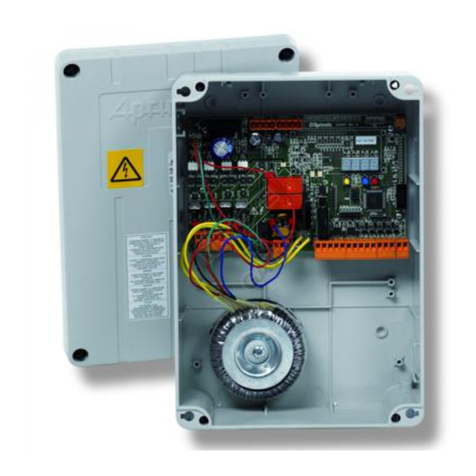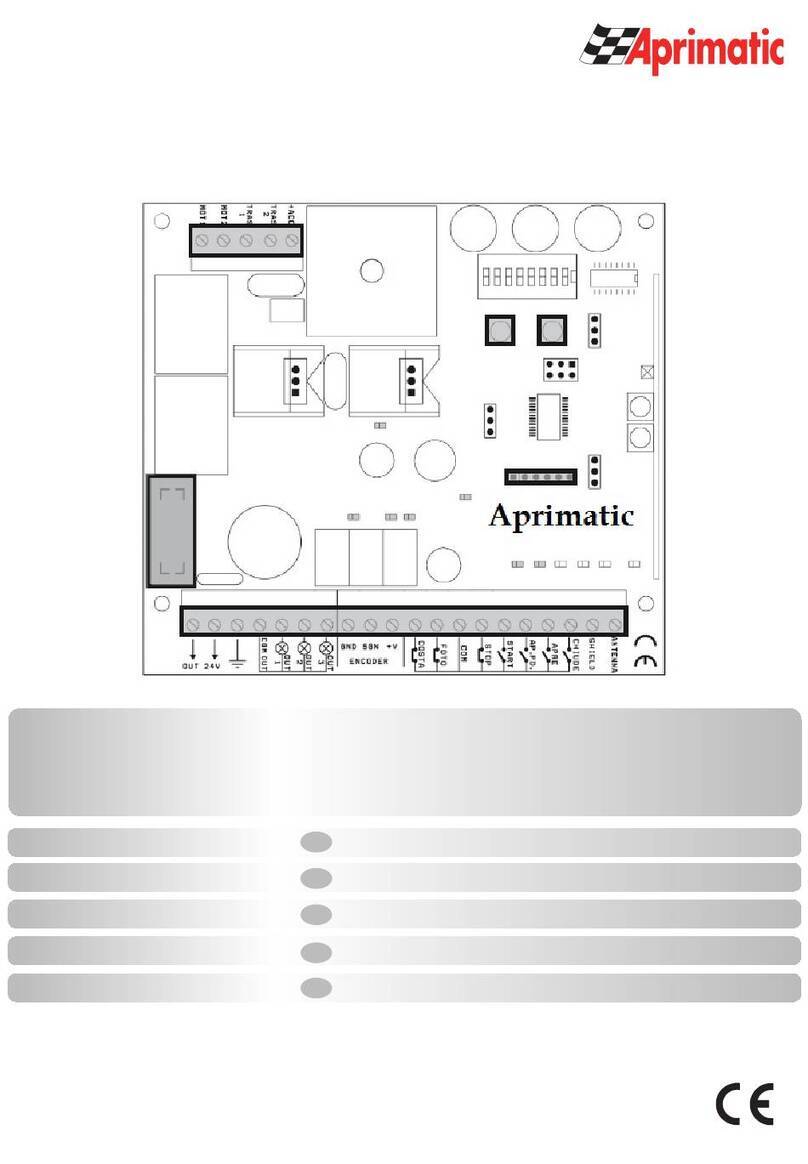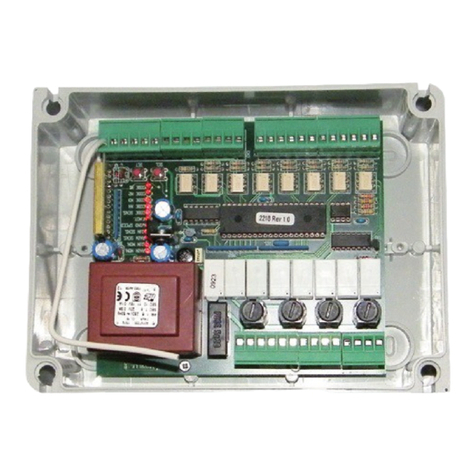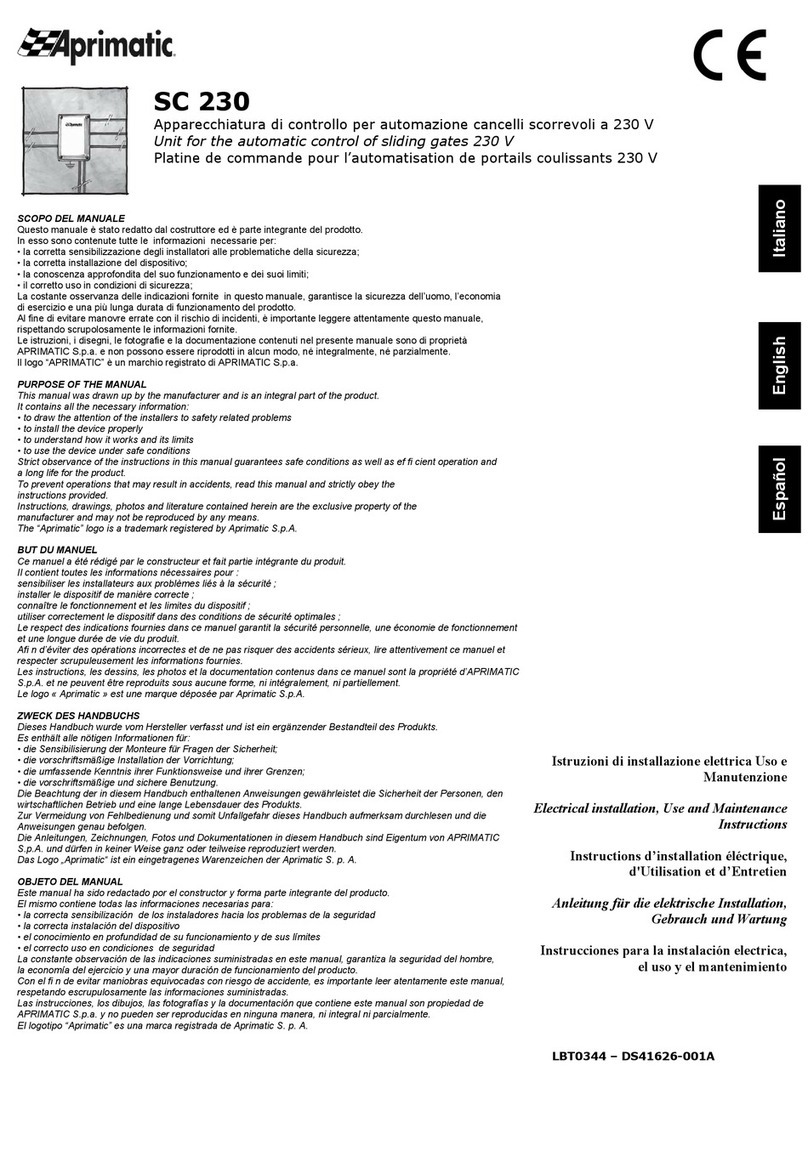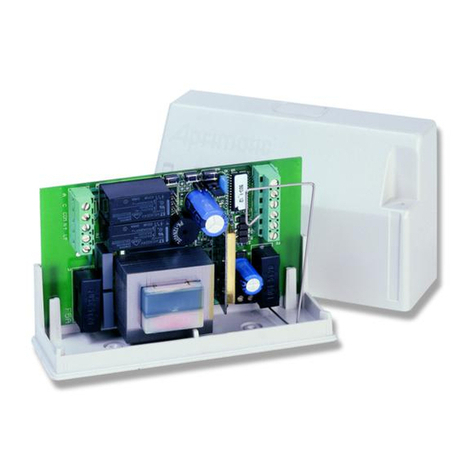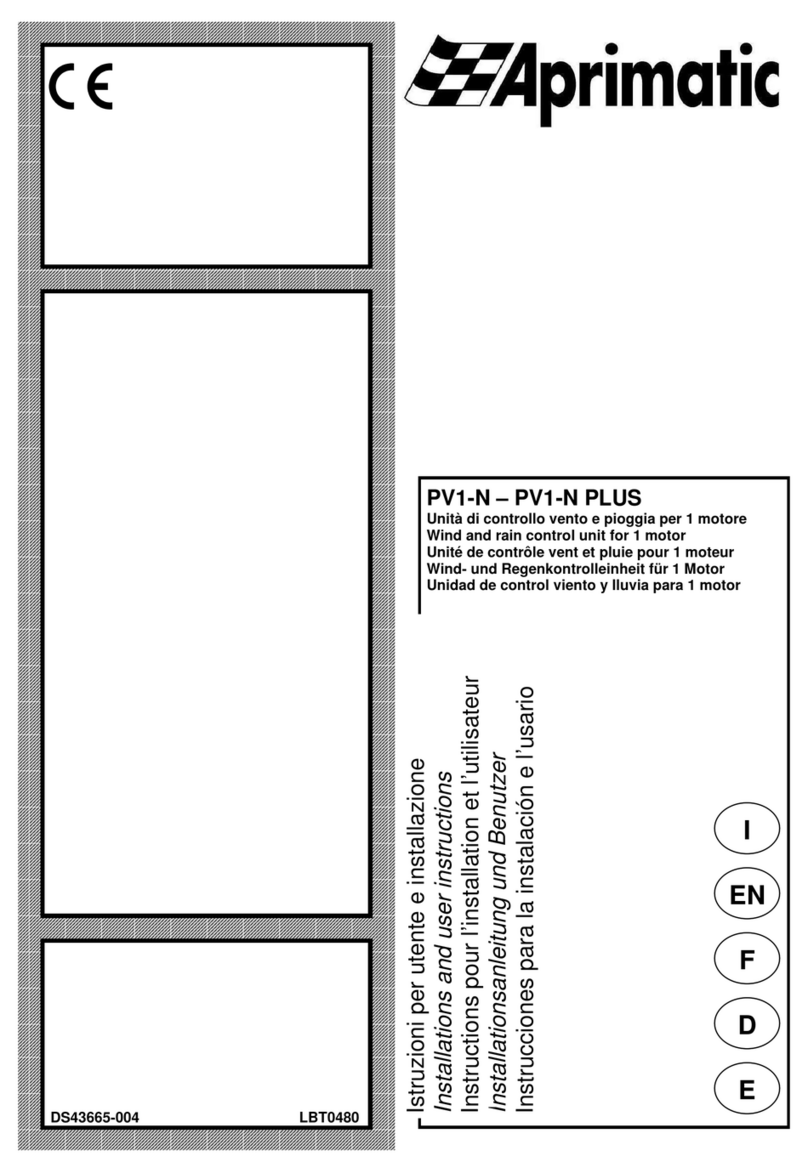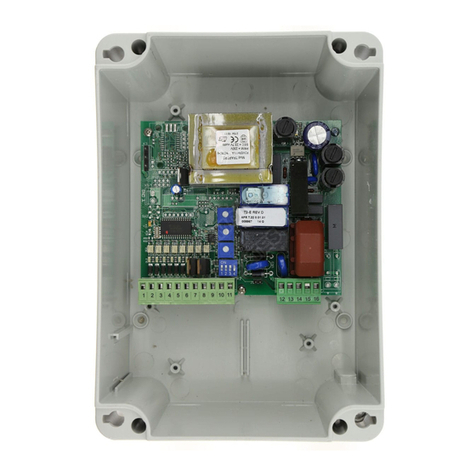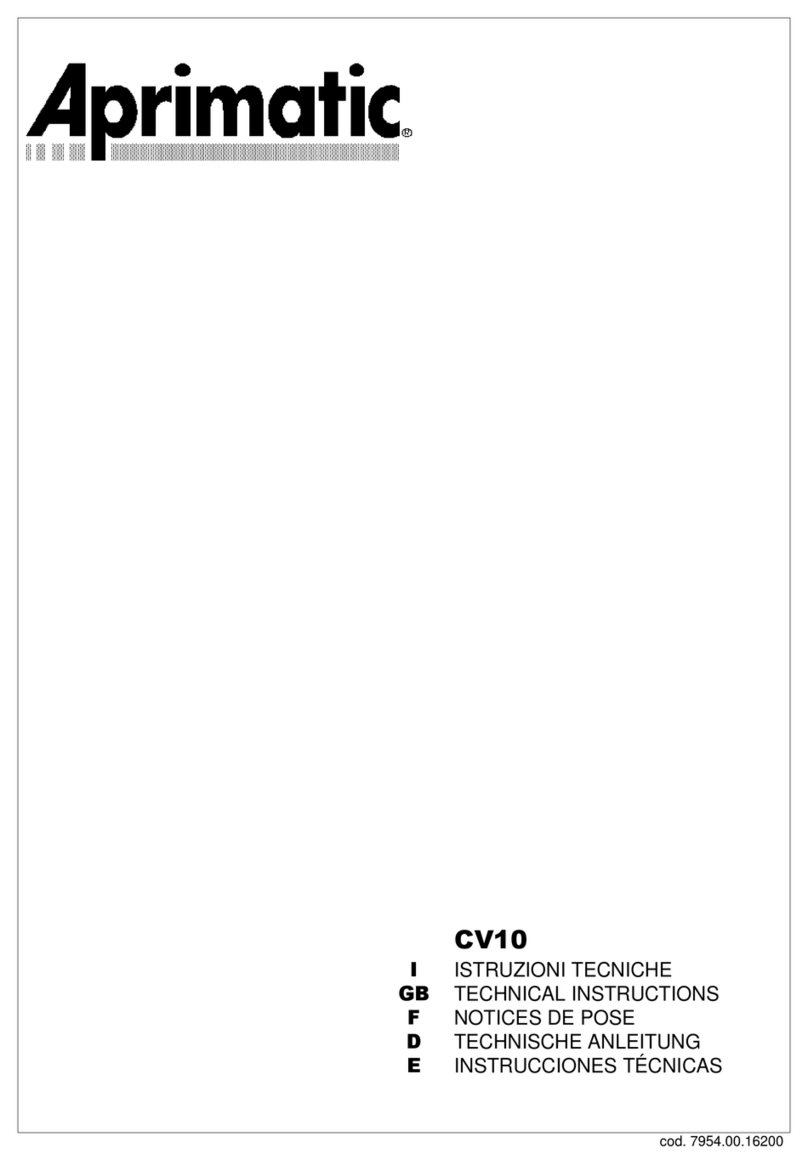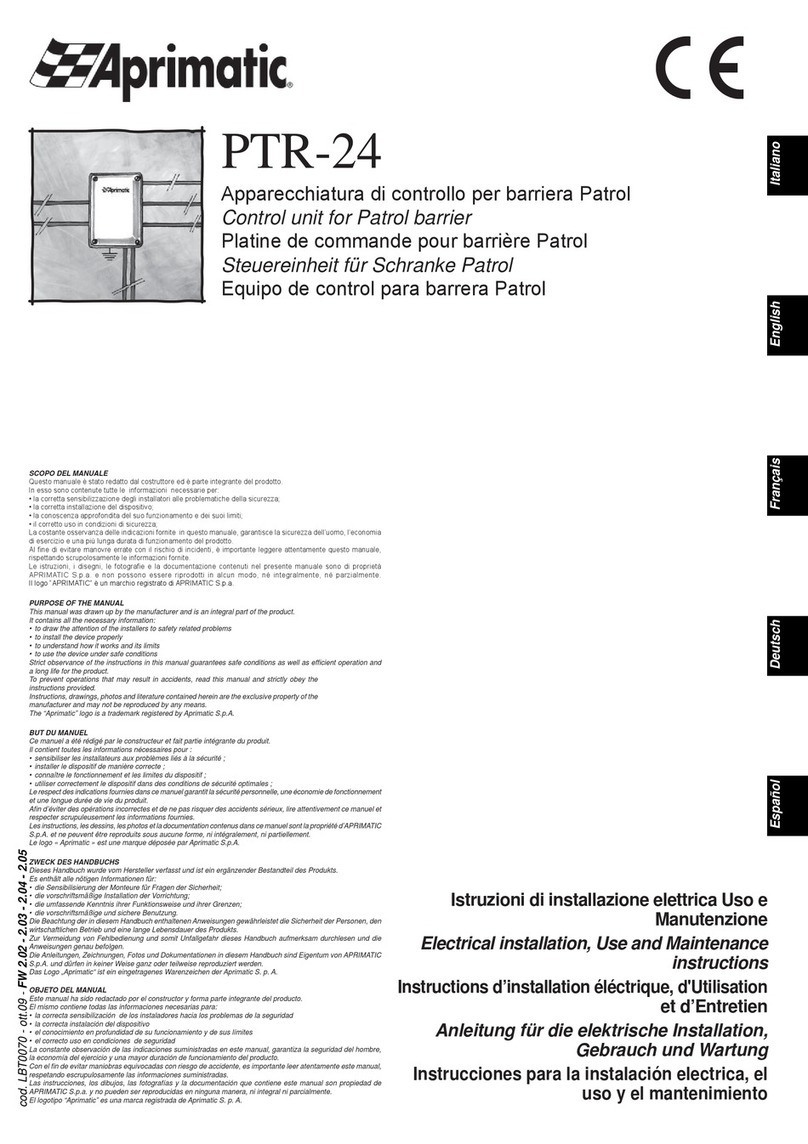
- 9-
ONDA 424/ONDA 624 APPARECCHIATURE DI CONTROLLO
Italiano
NOTE PER L'UTENTE E IL MANUTENTORE4.
Siricordachein baseallaD.M.89/392CEE, allaconclusione
dell’installazione occorre compilare una Dichiarazione di
ConformitàdellamacchinaeunaPropostadiManutenzione
Programmata e rilasciare tali documenti all’utente.
Manutenzione programmata4.1
Si raccomanda di consultare la Ditta Installatrice
dell’automazione e stabilire un piano di manutenzione
programmata, come richiesto dalle normative di settore.
Lamanutenzioneconsigliatada
AprimaticS.p.A.
perl’impianto
elettrico è elencata in
tabella
.
Aprimatic S.p.A.
via Leonardo da Vinci, 414
40059 Villa Fontana di Medicina - Bologna - Italia
Telf. +39 051 6960711 - fax +39 051 6960722
SPAZIO RISERVATO ALL’INSTALLATORE
SI PREGA DI CONSEGNARE COPIA DI QUESTA PAGINAALL’UTENTE
Operazione Periodicità
Verifica del buon funzionamento delle
sicurezze installate (fotocellule, coste…)
e del corretto funzionamento della frizione
elettronica.
Ogni 6 mesi
Controllare l’interno del contenitore
dell’apparecchiatura elettronica che deve
essere mantenuto pulito e preservato da
insetti o umidità.
Ogni 6 mesi
Verificare l’efficienza delle batterie
opzionali d’emergenza (se installate) ed
eventualmente sostituirle.
Ogni 6 mesi
Verificare l’efficienza delle batterie dei
telecomandi ed eventualmente sostituirle. Ogni 6 mesi
Eliminare eventuali ostacoli interposti che
oscurino permanentemente il raggio delle
fotocellule (es: rami o cespugli).
Ogni 6 mesi
Controllo del buon funzionamento
dell’impianto elettrico e della protezione
dell’interruttore differenziale.
Ogni 6 mesi
Controllare che l’ingresso del pulsante
di Stop sia collegato a un contatto N.C.,
VERIFICARNE IL FUNZIONAMENTO.
Ogni 6 mesi
Attenzione
!
La manutenzione va eseguita solo da personale
specializzato. Prima di eseguire la manutenzione
scollegarel’operatore dallarete dialimentazionemediante
l’interruttore differenziale dell’impianto elettrico.
Si ricorda che le batterie, in quanto materiale di consumo, non
sono coperte da garanzia.
Si raccomanda di non disperdere le batterie nell’ambiente, ma
di utilizzare gli appositi contenitori previsti presso i punti vendita
delle batterie stesse.
Ricerca guasti4.2
TIPO DI GUASTO PROBABILI CAUSE RIMEDI
Attivando il comando relativo il
cancello non si chiude.
Manca tensione.
Il circuito non è correttamente allacciato.
Il radio-comando non funziona.
L'apparecchiatura non funziona.
Il fine-corsa non è correttamente allacciato
oppure è guasto.
Lo sblocco è aperto.
L'allacciamento del motore al fine-corsa è
invertito e il motore spinge l'anta al contrario.
Regolare la sensibilità della frizione elettronica.
La cremagliera grava sul pignone o gli spezzoni
non sono alla corretta distanza tra di loro.
La guida presenta gradini o il cancello oppone
resistenza al moto.
La potenza del motoriduttore è insufficiente
rispetto alle caratteristiche del cancello.
Vi sono problemi con le fotocellule.
La polarità del motore è invertita.
E' in auto-apprendimento.
Verificare che gli allacciamenti all'apparecchiatura siano corretti o
non si siano scollegati e i contatti NC inutilizzati siano ponticellati.
Controllare che la batteria del radio-comando sia carica.
Controllare che la ricevente funzioni.
Controllare il fusibile F1.
Controllare le logiche dell'apparecchiatura.
Controllare il funzionamento e l'allacciamento del finecorsa.
Controllare che l' ingresso del pulsante di STOP sia
collegato ad un contatto N.C.
Chiudere lo sblocco manuale.
Ripristinare il corretto collegamento dei fine-corsa.
Tarare la regolazione di coppia (vedi manuale allegato).
Ricontrollare la cremagliera e ripristinare l'assetto corretto.
Controllare guida e ruote e migliorare la scorrevolezza.
Utilizzare un motoriduttore più potente (vedi Par. DATI TECNICI).
Controllare fotocellule e relativi allacciamenti.
Cambiare la posizione dei jumper (Reversing Motor).
Rivedere la posizione dei piastrini e i tempi di frenata.
Controllare il corretto funzionamento del finecorsa.
Ripristinare l'allacciamento alla tensione.
Il cancello si arresta contro il fermo meccanico
prima che lo stesso si sia fermato
automaticamente, causando il bloccaggio sotto
carico degli ingranaggi.
Lo sbocco a chiave oppone
note-vole resistenza o risulta
bloccato e al comando di apertura
il motore si avvia ma il cancello
Il motoriduttore funziona
lentamente.
Al comando di apertura il
cancello non si apre ed il
motore non entra in funzione.
Al comando di apertura il
motore si avvia ma l'anta non
si muove.
Il cancello si muove a scatti,
è rumoroso o si ferma a
metà corsa.
Sostituire l'apparecchiatura elettronica se non si riattiva la
velocità manuale.
